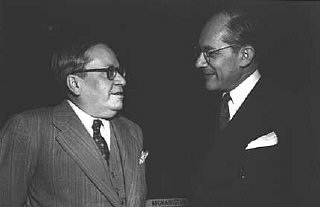


Raphael Lemkin (right) with Ambassador Amado of Brazil (left) before a plenary session of the General Assembly at which the Convention on the Prevention and Punishment of Genocide was approved. Palais de Chaillot, Paris, December 11, 1948.
— United Nations Archives and Records Management Section
Raphael Lemkin, a Polish-Jewish jurist, was born in 1900 on a small farm near the Polish town of Wolkowysk.
Lemkin's memoirs detail early exposure to the history of Ottoman attacks against Armenians (which most scholars believe constitute genocide), antisemitic pogroms, and other histories of group-targeted violence as key to forming his beliefs about the need for legal protection of groups. As early as 1933, he was working to introduce legal safeguards for ethnic, religious, and social groups at international forums, but without success. When the German army invaded Poland, he escaped from Europe, eventually reaching safety in the US, where he took up a teaching position at Duke University. He moved to Washington, DC, in the summer of 1942, to join the War Department as an analyst and went on to document Nazi atrocities in his 1944 book, Axis Rule in Occupied Europe. In this text, he introduced the word “genocide.”
“By ‘genocide’ we mean the destruction of a nation or of an ethnic group. This new word, coined by the author to denote an old practice in its modern development, is made from the ancient Greek word genos (race, tribe) and the Latin cide (killing)…. Generally speaking, genocide does not necessarily mean the immediate destruction of a nation, except when accomplished by mass killings of all members of a nation. It is intended rather to signify a coordinated plan of different actions aiming at the destruction of essential foundations of the life of national groups, with the aim of annihilating the groups themselves. Genocide is directed against the national group as an entity, and the actions involved are directed against individuals, not in their individual capacity, but as members of the national group” (80).
He later served with the team of Americans working to prepare the Nuremberg trials, where he was able to get the word “genocide” included in the indictment against Nazi leadership. But “genocide” was not yet a legal crime, and the verdict at Nuremberg did not cover peacetime attacks against groups, only crimes committed in conjunction with an aggressive war. While in Nuremberg, Lemkin also learned of the death of 49 members of his family, including his parents, in concentration camps, the Warsaw ghetto, and death marches.
He returned from Europe determined to see “genocide” added to international law and began lobbying for this at early sessions of the United Nations. His tireless efforts to enlist the support of national delegations and influential leaders eventually paid off. On December 9, 1948, the United Nations approved the Convention on the Prevention and Punishment of Genocide. Lemkin did not rest with the UN document, but committed the rest of his life to urging nations to pass legislation supporting the Convention. He died in 1959, impoverished and exhausted by his efforts.
What is Genocide? »
Genocide Timeline »
Incitement to Genocide in International Law »
The Story of Raphael Lemkin »
The Legacy of Raphael Lemkin »
Raphael Lemkin's History of Genocide and Colonialism »
Responding to Genocide Today »
Genocide Prevention Task Force »